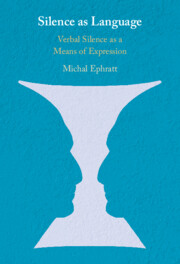
-
Select format
-
- Publisher:
- Cambridge University Press
- Publication date:
- August 2022
- August 2022
- ISBN:
- 9781108650779
- 9781108471671
- 9781108458214
- Dimensions:
- (235 x 158 mm)
- Weight & Pages:
- 0.69kg, 382 Pages
- Dimensions:
- (229 x 152 mm)
- Weight & Pages:
- 0.551kg, 382 Pages
You may already have access via personal or institutional login
Book description
Verbal silence touches on every possible aspect of daily life. This book provides a full linguistic analysis of the role of silence in language, exploring perspectives from semantics, semiotics, pragmatics, phonetics, syntax, grammar and poetics, and taking into account a range of spoken and written contexts. The author argues that silence is just as communicative in language as speech, as it results from the deliberate choice of the speaker, and serves functions such as informing, conveying emotion, signalling turn switching, and activating the addresser. Verbal silence is used, alongside speech, to serve linguistic functions in all areas of life, as well as being employed in a wide variety of written texts. The forms and functions of silence are explained, detailed and illustrated with examples taken from both written texts and real-life interactions. Engaging and comprehensive, this book is essential reading for anyone interested in this fascinating linguistic phenomenon.
Reviews
‘The author succeeds in providing a unique perspective on silence and its power to convey meaning and will leave the reader with a deeper appreciation for this often-overlooked aspect of human interaction.’
Răzvan Săftoiu Source: Language and Dialogue
Contents
Metrics
Altmetric attention score
Full text views
Full text views help Loading metrics...
Loading metrics...
* Views captured on Cambridge Core between #date#. This data will be updated every 24 hours.
Usage data cannot currently be displayed.
Accessibility standard: Unknown
Accessibility compliance for the PDF of this book is currently unknown and may be updated in the future.


